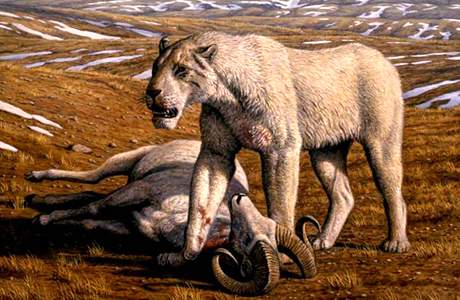The Yukon Horse
The Yukon horse (Equus (ferus) lambei) was a pony-sized equid that inhabited the northern parts of Canada and Alaska until approximately twelve thousand years ago, when it was presumably hunted to extinction by newly arrived paleo-natives. Thanks to relatively plentiful frozen and fossil specimens, more is known about it's diet and appearance than other North American horse species. For example, it is known that it had roughly the same colouring, size, and body conformation as the extant Przewalski's horse (Equus ferus przewalski). However, there are some notable differences in colouring and fur qualities. Like Przewalski's horses, the Yukon horse was dun coloured with a dorsal stripe and other primitive markings, but where Przewalski's horses have short, rigid, black manes, somewhat akin to a zebra's, the Yukon horse had a mane much more similar to that of domestic horses. The main was long and flaxen, and according to preserved animals, blonde. These horses also had a very thick winter coat that would have allowed them to survive in the same Arctic conditions as mammoths, muskoxen, bison, and reindeer. They would have served an important ecological role as prey animals, fertilizers, and removers of snow and heavy grass, helping to control and remove the insulation layer over the permafrost.
Takhis
While the obvious solution might be to use Przewalski's horses as unaltered proxies for the Yukon horse, it is in actuality not the best or most practical solution. Takhis, as Przewalski's horses are sometimes called, are not as well-adapted to cold conditions as some of their domestic cousins are, and might prove unable to survive in the Canadian Arctic. However, as the only true wild horse remaining in existence, it is desirable to preserve some of their wild behaviour and physical traits in any feral horse population. As far as their use in the Yukon Horse Project (not an official name or institution, but sounds cool), their contribution would be limited to occasional inseminations of project mares using material from takhi stallions shipped overseas or from North American zoos. Their mane colour and coat features would have to be selected against, but their coat colour is acceptable. They are perhaps a little large as well, standing fourteen hands (approximately one point four meters) at the shoulder where the Yukon horse stood approximately twelve hands (approximately one point two meters). Smaller surface area compared to volume is an adaptation to cold weather, as are shorter legs, and so these are additional traits that should be selected for, along with small ears, large snouts, and large guts/organs. Takhi behavioural traits will be important as well, due to their never having been domesticated. They will not be tempted to approach humans and will have more appropriate reactions to predators, such as wolves, bears, and eventually, large cats.
Yakut Ponies
Perhaps the best candidate for a Yukon horse proxy is the Yakutian pony of northern Siberia. Regularly surviving temperatures as low as minus sixty degrees Celsius, and often living in semi-feral conditions, Yakut ponies are rumoured to have Yukon horse blood already, though that is in truth doubtful. However, their extreme climatic adaptability and wild nature make them ideal candidates for recreating the Yukon horse. Their height is good, standing at around twelve hands. Fur colour is varied, but the appropriate dun colour with primitive markings, as well as blonde, flaxen manes can be found commonly in the population. Their thick coat is particularly desirable for the project. Yakut horses are already being used in the Pleistocene Park project as proxies for west Beringian horses, and have been quite successful in excavating snow and controlling grass growth.
Fjord Ponies
Another good breed for possible use is the Norwegian fjord pony, a slightly larger, stronger breed. The fjord horse is a very old breed, being relatively unchanged for about ten thousand years. They are of particular interest to this project due to their colouring, which is very similar to that of the Yukon horse. They are also a cold-adapted, semi-feral breed that has retained many primitive traits. Their height is a little tall, at about fourteen hands.
Icelandic Ponies
The third and final domestic breed for possible use is the Icelandic horse. A smaller breed at twelve to thirteen hands, it is a similar breed to the Yakut horse, with a thick pelt and varied coat colouring. These horses are kept mostly wild in their homeland. The concern with this breed is that obtaining them from Iceland would be very difficult.
Conclusions
The Yukon Horse Project will be set up as an ongoing project in northern rewilding reserves. The best plan of action it seems is to start with a very large herd of maybe fifty mares, made up mostly of Yakut horses and perhaps a few Icelandic horses, all with dun coats and blonde manes. This herd will have one or two Norwegian fjord stallions added to the mix to control the herd and create a second generation. This herd will have occasional introductions of new animals as well as occasional conceptions of foals through artificial insemination by Takhis. Horses will be allowed to breed as necessary, and will be subject to natural selection. The only interference will be the occasional sterilization of animals with undesirable traits with colour or size. The environment will weed out animals that cannot handle the low temperatures.
Further Reading
http://www.tc.gov.yk.ca/publications/Yukon_Horse_2002.pdf
https://www.rewildingeurope.com/wp-content/uploads/2014/09/Rewilding-horses-in-Europe-2014.pdf
Pictures
Yukon Horse Depiction - http://www.beringia.com/sites/default/files/Yukon-horse-banner.jpg
Takhi - https://foxstudio.files.wordpress.com/2008/11/takhi-berlin21.jpg
Yakut Pony - http://farm9.static.flickr.com/8691/17082533617_e5d7d25860.jpg
Fjord Pony - http://www.horsebreedspictures.com/wp-content/uploads/2015/10/Fjord-Horse-in-Snow.jpg
Icelandic Pony - http://bna-art.s3.amazonaws.com/www.bootsnall.com/articles/wp-content/uploads/2012/05/horses_iceland.jpg





